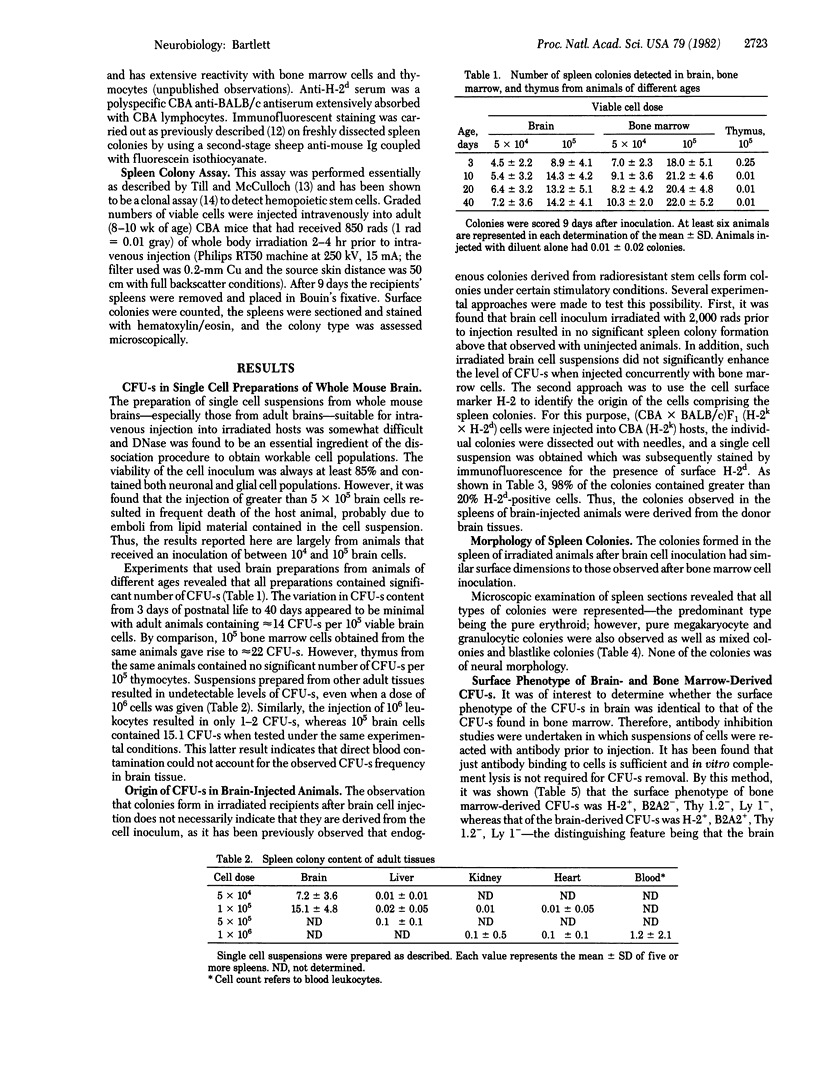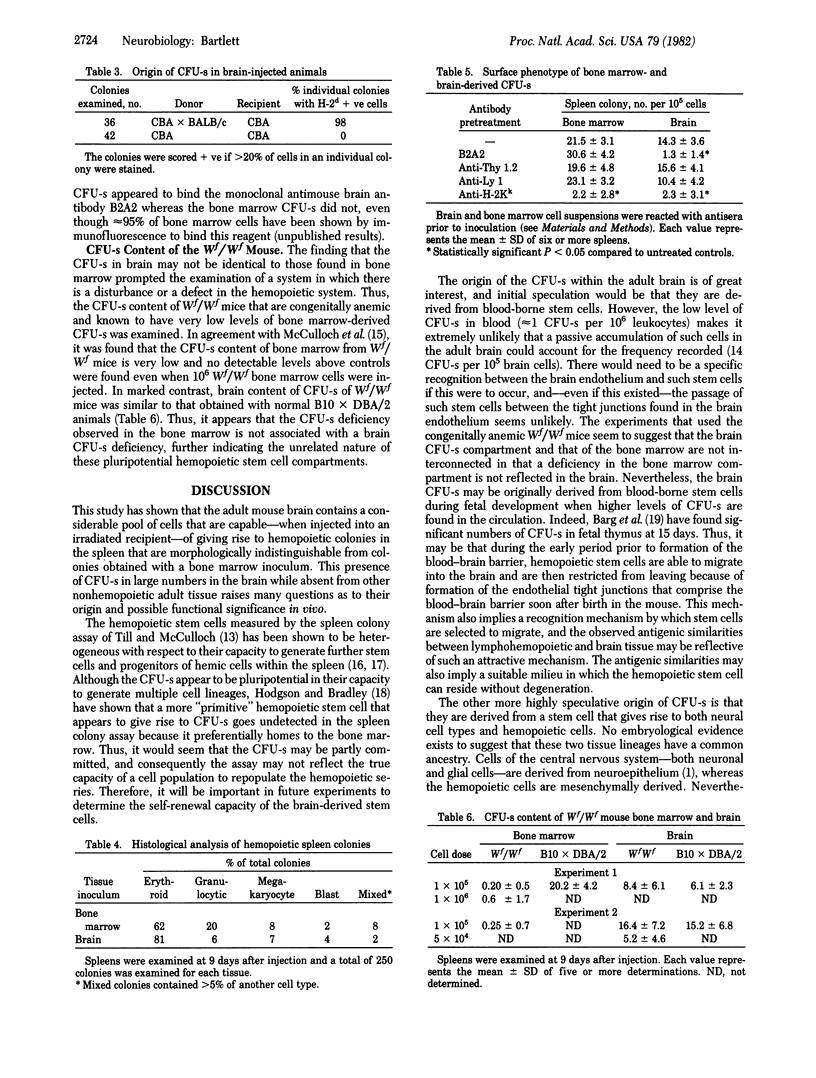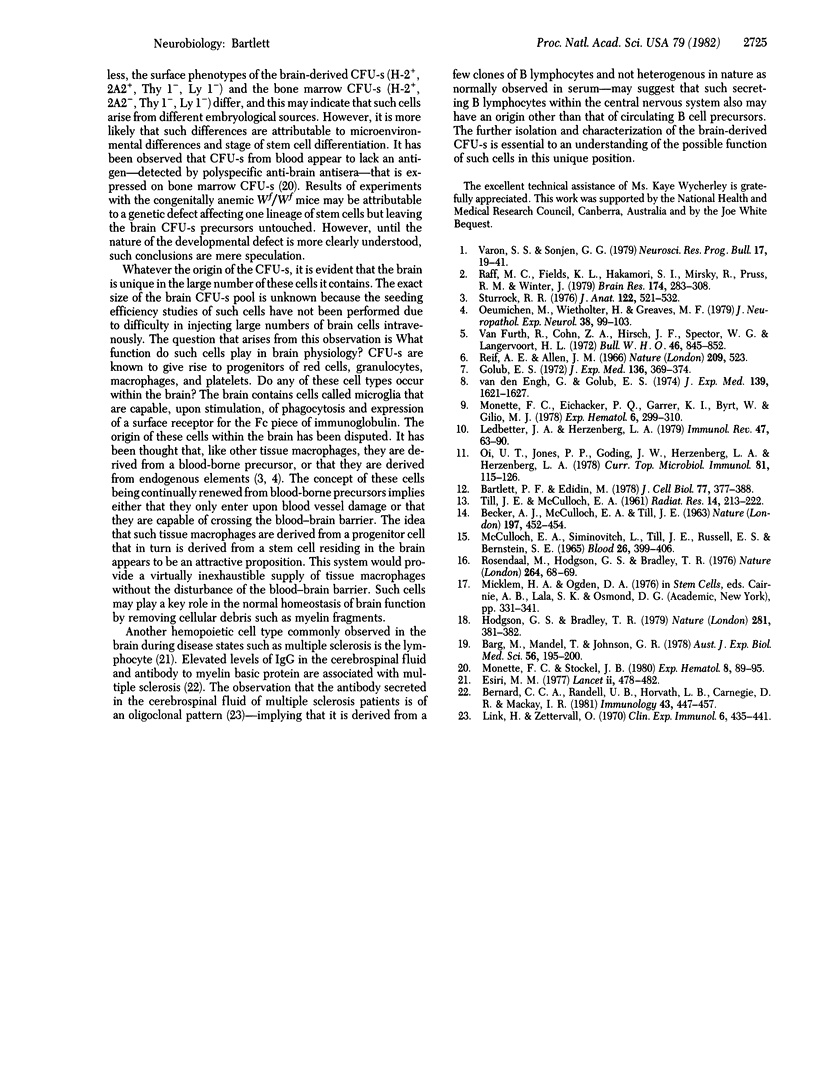Abstract
Single cell suspensions of adult mouse brain were shown to contain large numbers of pluripotential hemopoietic stem cells as detected by the ability to form hemopoietic colonies in the spleens of irradiated hosts. These colony forming unit, spleen (CFU-s) cells derived from brain gave rise to colonies identical in morphology and histology to those of bone marrow-derived CFU-s. The average number of CFU-s obtained per 10(5) dissociated adult brain cells was 14, whereas other adult tissues such as lung, kidney, heart, and thymus contained insignificant CFU-s levels when tested. As the level of CFU-s in adult blood is less than 1 per 10(6) nucleated cells, blood contamination does not contribute to the high levels found in adult brain. Individual spleen colonies isolated from irradiated CBA (H-2k) recipients injected with (BALB/c x CBA)F1 (H-2d x H-2k) brain cells were shown by immunofluorescence to contain cells bearing surface H-2d molecules, thus indicating that the colonies arose from the brain cell inoculum and were not endogenously derived. The surface phenotype of brain- and bone marrow-derived CFU-s was found to differ in that brain CFU-s could be inhibited by prior incubation with a monoclonal antibrain antibody B2A2, whereas bone marrow CFU-s were not. Further differences were found between brain and bone marrow CFU-s in the congenitally anemic Wf/Wf mice. These mice were shown to have a very few CFU-s in the adult bone marrow, whereas the brain contained normal adult levels. The large number of hemopoietic stem cells in the brain may indicate an essential requirement for the continual generation of cells such as microglia or phagocytic cells, without the disruption of the blood-brain barrier.
Full text
PDF



Selected References
These references are in PubMed. This may not be the complete list of references from this article.
- BECKER A. J., McCULLOCH E. A., TILL J. E. Cytological demonstration of the clonal nature of spleen colonies derived from transplanted mouse marrow cells. Nature. 1963 Feb 2;197:452–454. doi: 10.1038/197452a0. [DOI] [PubMed] [Google Scholar]
- Barg M., Mandel T. E., Johnson G. R. Haemopoietic stem cells in the foetal mouse thymus. Aust J Exp Biol Med Sci. 1978 Apr;56(2):195–200. doi: 10.1038/icb.1978.21. [DOI] [PubMed] [Google Scholar]
- Bartlett P. F., Edidin M. Effect of the H-2 gene complex rates of fibroblast intercellular adhesion. J Cell Biol. 1978 May;77(2):377–388. doi: 10.1083/jcb.77.2.377. [DOI] [PMC free article] [PubMed] [Google Scholar]
- Bernard C. C., Randell V. B., Horvath L. B., Carnegie P. R., Mackay I. R. Antibody to myelin basic protein in extracts of multiple sclerosis brain. Immunology. 1981 Jul;43(3):447–457. [PMC free article] [PubMed] [Google Scholar]
- Esiri M. M. Immunoglobulin-containing cells in multiple-sclerosis plaques. Lancet. 1977 Sep 3;2(8036):478–478. doi: 10.1016/s0140-6736(77)91603-8. [DOI] [PMC free article] [PubMed] [Google Scholar]
- Golub E. S. Brain-associated stem cell antigen: an antigen shared by brain and hemopoietic stem cells. J Exp Med. 1972 Aug 1;136(2):369–374. doi: 10.1084/jem.136.2.369. [DOI] [PMC free article] [PubMed] [Google Scholar]
- Hodgson G. S., Bradley T. R. Properties of haematopoietic stem cells surviving 5-fluorouracil treatment: evidence for a pre-CFU-S cell? Nature. 1979 Oct 4;281(5730):381–382. doi: 10.1038/281381a0. [DOI] [PubMed] [Google Scholar]
- Ledbetter J. A., Herzenberg L. A. Xenogeneic monoclonal antibodies to mouse lymphoid differentiation antigens. Immunol Rev. 1979;47:63–90. doi: 10.1111/j.1600-065x.1979.tb00289.x. [DOI] [PubMed] [Google Scholar]
- Link H., Zettervall O. Multiple sclerosis: disturbed kappa: lambda chain ratio of immunoglobulin G in cerebrospinal fluid. Clin Exp Immunol. 1970 Mar;6(3):435–438. [PMC free article] [PubMed] [Google Scholar]
- McCulloch E. A., Siminovitch L., Till J. E., Russell E. S., Bernstein S. E. The cellular basis of the genetically determined hemopoietic defect in anemic mice of genotype Sl-Sld. Blood. 1965 Oct;26(4):399–410. [PubMed] [Google Scholar]
- Monette F. C., Eichacker P. Q., Garver R. I., Byrt W., Gilio M. J. Characterization of the anti-stem cell activity of anti-mouse brain serum. Exp Hematol. 1978 Mar;6(3):299–310. [PubMed] [Google Scholar]
- Monette F. C., Stockel J. B. Blood-borne stem cells are immunologically distinct from those in other hematopoietic tissues. Exp Hematol. 1980 Jan;8(1):89–95. [PubMed] [Google Scholar]
- Oehmichen M., Wiethölter H., Greaves M. F. Immunological analysis of human microglia: lack of monocytic and lymphoid membrane differentiation antigens. J Neuropathol Exp Neurol. 1979 Mar;38(2):99–103. doi: 10.1097/00005072-197903000-00002. [DOI] [PubMed] [Google Scholar]
- Oi V. T., Jones P. P., Goding J. W., Herzenberg L. A., Herzenberg L. A. Properties of monoclonal antibodies to mouse Ig allotypes, H-2, and Ia antigens. Curr Top Microbiol Immunol. 1978;81:115–120. doi: 10.1007/978-3-642-67448-8_18. [DOI] [PubMed] [Google Scholar]
- Raff M. C., Fields K. L., Hakomori S. I., Mirsky R., Pruss R. M., Winter J. Cell-type-specific markers for distinguishing and studying neurons and the major classes of glial cells in culture. Brain Res. 1979 Oct 5;174(2):283–308. doi: 10.1016/0006-8993(79)90851-5. [DOI] [PubMed] [Google Scholar]
- Reif A. E., Allen J. M. Mouse nervous tissue iso-antigens. Nature. 1966 Jan 29;209(5022):523–523. doi: 10.1038/209523a0. [DOI] [PubMed] [Google Scholar]
- Rosendaal M., Hodgson G. S., Bradley T. R. Haemopoietic stem cells are organised for use on the basis of their generation-age. Nature. 1976 Nov 4;264(5581):68–69. doi: 10.1038/264068a0. [DOI] [PubMed] [Google Scholar]
- Sturrock R. R. Light microscopic identification of immature glial cells in semithin sections of the developing mouse corpus callosum. J Anat. 1976 Dec;122(Pt 3):521–537. [PMC free article] [PubMed] [Google Scholar]
- TILL J. E., McCULLOCH E. A. A direct measurement of the radiation sensitivity of normal mouse bone marrow cells. Radiat Res. 1961 Feb;14:213–222. [PubMed] [Google Scholar]
- Van den Engh G. J., Golub E. S. Antigenic differences between hemopoietic stem cells and myeloid progenitors. J Exp Med. 1974 Jun 1;139(6):1621–1627. doi: 10.1084/jem.139.6.1621. [DOI] [PMC free article] [PubMed] [Google Scholar]
- van Furth R., Cohn Z. A., Hirsch J. G., Humphrey J. H., Spector W. G., Langevoort H. L. The mononuclear phagocyte system: a new classification of macrophages, monocytes, and their precursor cells. Bull World Health Organ. 1972;46(6):845–852. [PMC free article] [PubMed] [Google Scholar]


